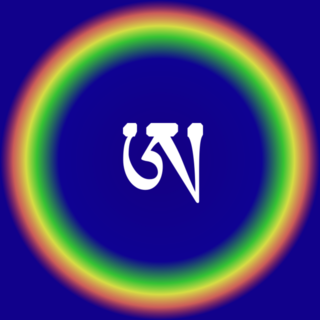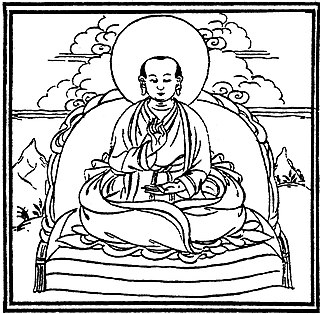
Longchen Rabjam Drimé Özer, commonly abbreviated to Longchenpa was a Tibetan scholar-yogi of the Nyingma school of Tibetan Buddhism. According to tibetologist David Germano, Longchenpa's work led to the dominance of the Longchen Nyingthig lineage of Dzogchen over the other Dzogchen traditions. He is also responsible for the scholastic systematization of Dzogchen thought within the context of the wider Tibetan Vajrayana tradition of philosophy which was highly developed at the time among the Sarma schools. Germano also notes that Longchenpa's work is "generally taken to be the definitive expression of the Great Perfection with its precise terminological distinctions, systematic scope, and integration with the normative Buddhist scholasticism that became dominant in Tibet during the thirteenth and fourteenth centuries."

Dzogchen, also known as atiyoga, is a tradition of teachings in Indo-Tibetan Buddhism and Yungdrung Bon aimed at discovering and continuing in the ultimate ground of existence. The primordial ground is said to have the qualities of purity, spontaneity and compassion. The goal of Dzogchen is knowledge of this basis, this knowledge is called rigpa. There are numerous spiritual practices taught in the various Dzogchen systems for awakening rigpa.

In Dzogchen, rigpa is knowledge of the ground. The opposite of rigpa is ma rigpa. A practitioner who has attained the state of rigpa and is able to rest there continuously is called a Rigdzin, which may be used as a title either pre- or post-nominally.

Nyingma is the oldest of the four major schools of Tibetan Buddhism. It is also often referred to as Ngangyur, "order of the ancient translations". The Nyingma school is founded on the first lineages and translations of Buddhist scriptures from Sanskrit into Tibetan in the eighth century, during the reign of King Trisong Detsen.

Jigme Lingpa (1730–1798) was a Tibetan tertön of the Nyingma lineage of Tibetan Buddhism. He was the promulgator of the Longchen Nyingthig, the Heart Essence teachings of Longchenpa, from whom, according to tradition, he received a vision in which the teachings were revealed. The Longchen Nyingthik eventually became the most famous and widely practiced cycle of Dzogchen teachings.
In Tibetan Buddhism, Ngöndro refers to the preliminary, preparatory or foundational practices or disciplines common to all four schools of Tibetan Buddhism and also to Bon. They precede deity yoga.
Nyingtig Yabshi. One of the most famous collections of Dzogchen scriptures. Vimalamitra united the two aspects of Innermost Unexcelled Section — the explanatory lineage with scriptures and the hearing lineage without scriptures — and concealed them to be revealed as the Nyingtig teachings Vima Nyingtig, and also as the Secret Heart Essence of Vimalamitra. Longchenpa clarified them in his 51 sections of Lama Yangtig. Padmakara concealed his teachings on the Innermost Unexcelled Cycle to be revealed in the future as Khandro Nyingtig, the Heart Essence of the Dakinis. Longchenpa also clarified these teachings in his Khandro Yangtig. These four exceptional sets of Dzogchen instructions are, together with Longchenpa's additional teachings Zabmo Yangtig, contained in his collection, Nyingtig Yabshi.

Semde translated as 'mind division', 'mind class' or 'mind series' is the name of one of three scriptural and lineage divisions within Atiyoga, Dzogchen or the Great Perfection which is itself the pinnacle of the ninefold division of practice according to the Nyingma school of Tibetan Buddhism.
Longdé is the name of one of three scriptural divisions within Dzogchen, which is itself the pinnacle of the ninefold division of practice according to the Nyingma school of Tibetan Buddhism.

Longchen Nyingthig is a terma, revealed scripture, of the Nyingma school of Tibetan Buddhism, which gives a systematic explanation of Dzogchen. It was revealed by Jigme Lingpa (1730–1798).
Sri Singha was the teacher of Padmasambhava, Vimalamitra, and Vairotsana. He was a principal student and dharma-son of Mañjuśrīmitra in the Dzogchen lineage, and is credited by the Nyingma school with introducing Dzogchen to Tibet.
According to the Nyingmapa tradition of Tibetan Buddhism, the Dzogchen masters Manjushrimitra and Shrisimha were already active in the Tantric milieu in India independently. However, Manjushrimitra, a learned scholar of Brahman origin, was evidently an adherent of the Yogachara school before his becoming a disciple of the mysterious Prahevajra or Garab Dorje from the country of Uddiyana. It should also be recalled that his disciple Shrisimha was said to have born and resided for some time in China before coming to India. And that the latter's disciple Vimalamitra visited China before and after he came to Tibet and transmitted the Dzogchen teachings to his disciples at Samye Monastery.
Rongzom Chökyi Zangpo, widely known as Rongzom Mahapandita, Rongzom Dharmabhadra, or simply as Rongzompa, was one of the most important scholars of the Nyingma school of Tibetan Buddhism. Together with Longchenpa and Ju Mipham, he is often considered to be one of the three "omniscient" writers of the school. His elder contemporary Atiśa (980–1054) considered Rongzompa to be an incarnation of the Indian ācārya Kṛṣṇapāda, the Great. The Tibetan historian Gö Lotsawa (1392–1481) said of Rongzom that no scholar in Tibet was his equal.
sNub-Ben Namkha'i Nyingpo is counted amongst the principal "twenty-five disciples" of Padmasambhava. sNub Ben Namkha'i Nyingpo was a realized practitioner of Śāntarakṣita’s tradition of Sutrayana "gradualist" Mahayana Buddhism as well as simultaneously being one of the most accomplished Tibetan practitioners of the East Mountain Teaching of Chan Buddhism, which transmits the "subitist" tradition of Mahayana Buddhism.
Vima Nyingthig, "Seminal Heart of Vimalamitra", in Tibetan Buddhism is one of the two "seminal heart" collections of the menngagde cycle Dzogchen, the other one being "Seminal Heart of the Dakini". Traditionally the teachings are ascribed to Vimalamitra, but they were codified and collated by their Tibetan discoverers in the 11th and 12th century. The main discoverer of the Vima Nyingthig was Zhangtön Tashi Dorjé.

The Seventeen Tantras of the Esoteric Instruction Series or the Seventeen tantras of the Ancients are an important collection of tantras in the Nyingma school of Tibetan Buddhism. They comprise the core scriptures of the "esoteric instruction series" (Menngagde) of Dzogchen teachings and are its most authoritative scriptures.

Yuthok Yonten Gonpo the Younger (1126–1202) was a Tibetan doctor and ngakpa, credited with composing the Four Medical Tantras, a four-book treatise on Traditional Tibetan Medicine which forms the main course of study in the Tibetan medical tradition. He is widely regarded as the main founder of Tibetan medicine, mostly based on his composition of the Four Medical Tantras. His other important contribution to Tibetan culture was the Yuthok Nyingthik, whose full name is the Yuthok Nyingthik Guru Sādhanā, ‘Compassionate Sunlight for Dispersing Suffering’s Darkness’, which is the main Tantric Buddhist practice-cycle associated with Tibetan medicine. It is traditionally considered to be an important spiritual component of healing in Tibetan medical culture, and moreover is regarded in all Tibetan Buddhist traditions as a very special method for attaining awakening and realization quickly.

In Dzogchen, trekchö means "(spontaneous) cutting of tension" or "cutting through solidity." The practice of trekchö reflects the earliest developments of Dzogchen, with its admonition against practice. In this practice one first identifies, and then sustains recognition of, one's own innately pure, empty awareness. The main trekchö instructions in the Lamrim Yeshe Nyingpo state "This instant freshness, unspoiled by the thoughts of the three times; You directly see in actuality by letting be in naturalness."

In Dzogchen, tögal literally means "crossing the peak." It is sometimes translated as 'leapover,' 'direct crossing,' or 'direct transcendence.' Tögal is also called "the practice of vision," or "the practice of the Clear Light" (od-gsal).

Dzogchen, also known as atiyoga, is a tradition of teachings in Indo-Tibetan Buddhism aimed at discovering and continuing in the ultimate ground of existence. The primordial ground is said to have the qualities of purity, spontaneity and compassion. The goal of Dzogchen is knowledge of this basis, this knowledge is called rigpa. There are numerous spiritual practices taught in the various Dzogchen systems for recognizing rigpa.

Zhangtön Tashi Dorjé was a Tibetan Buddhist Dzogchen teacher who was an important treasure revealer (terton) in the Menngagde lineage of Dzogchen. He is particularly known for revealing the Vima Nyingthig, a key Dzogchen cycle of teachings which includes the Seventeen tantras of Dzogchen. Zhangton was born in Yamdrok Tonang and was a disciple of Chetsün Sengé Wangchuk.










